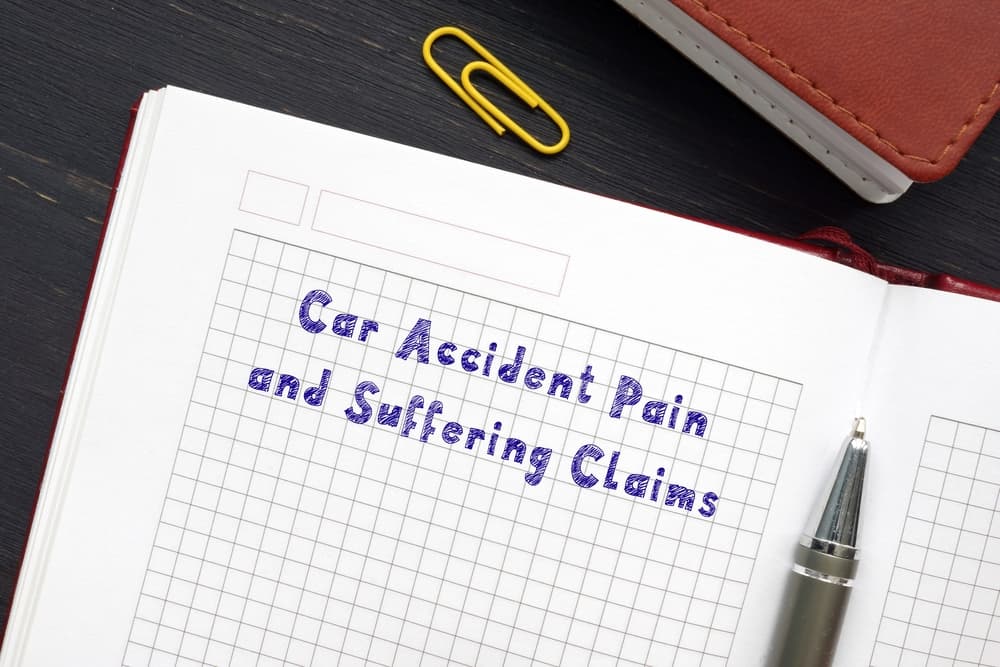A car accident can leave you with physical injuries, emotional distress, and financial burdens. After a car crash that wasn't your fault, you may recover compensation for your pain and suffering. But what exactly is pain and suffering, and how much can you expect to receive? Let the seek assistance from a experienced car accident lawyer near you.
Pain and Suffering Explained

Pain and suffering is a legal term that refers to the physical and emotional distress caused by an injury or accident. It encompasses both the actual pain experienced from the injury itself, as well as the suffering and anguish that comes with the trauma of the accident.
Physical Pain and Suffering
This includes:
- The immediate pain from the injuries sustained in the accident
- Ongoing pain from injuries that require long-term treatment or recovery
- Pain and discomfort from medical treatments like surgeries or physical therapy
Emotional Pain and Suffering
This consists of:
- Anxiety, depression, and emotional distress from the accident trauma
- Loss of enjoyment of life due to limited mobility or lifestyle changes
- Psychological impacts like post-traumatic stress disorder (PTSD)
Factors Affecting Pain and Suffering Damages
Several factors go into calculating fair pain and suffering damages after a car accident. Insurance companies and courts will consider:
The Severity of Your Injuries

The severity and extent of your injuries play a major role in determining pain and suffering compensation amounts. More serious, life-changing injuries that have long-lasting impacts tend to result in much higher pain and suffering awards compared to relatively minor injuries.
For example, catastrophic injuries like paralysis, traumatic brain injuries, severe burns, organ damage, or injuries requiring amputation are usually awarded maximum pain and suffering damages.
These injuries drastically diminish the quality of life, require excruciating treatments, and cause permanent disfigurement or disability that the victim must endure for the rest of their life.
On the other hand, less severe injuries like sprains, whiplash, or minor lacerations that heal relatively quickly are typically awarded lower pain and suffering amounts. However, the pain and recovery process for these injuries should not be discounted.
Even "minor" injuries can still cause significant suffering in the short-term from intense pain, missed time from work, temporary disability, and disruption to daily life during recovery. An experienced lawyer can make sure even these types of injuries are properly compensated.
The Length of Recovery
The severity of the injury is closely tied to the length of time it takes to recover. Injuries requiring lengthy hospital stays, multiple intensive treatments like surgeries, and months or years of physical therapy and rehabilitation generally warrant higher pain and suffering compensation.
Longer recovery periods mean longer periods of suffering from physical pain, emotional distress, disability, and loss of enjoyment of life's activities.
For example, a victim who suffers compound fractures that require emergency surgery, metal rods or plates implanted, and six to 12 months of intensive physical therapy to regain mobility would receive much higher pain and suffering compensation than a victim with a simple fracture that heals in six to eight weeks.
The longer recovery time for the compound fracture means:
- Drastically more suffering endured
- More invasive treatments
- Disability for a greater period
- Disruption to the victim's normal work and home life over an extended period
Professional experts like doctors, physical therapists, and psychologists are often called to provide evidence documenting the length of recovery, the extent of treatments required, and the overall hardships the victim has endured. This quantifies the appropriate pain and suffering compensation for injuries with longer healing periods.
Daily Life Impacts
Pain and suffering damages also take into account how significantly the injuries have impacted the victim's ability to maintain their normal daily life activities, quality of life, and ability to work and earn income.
If the injuries made routine personal care like bathing, dressing, or household chores extremely difficult or impossible without assistance from others, this demonstrates an elevated degree of suffering that should increase compensation amounts.
Similarly, injuries that force the victim to take long periods of unpaid leave from work or change careers entirely due to physical limitations show a major loss of income and financial hardship that get factored into pain and suffering awards.
Injuries that prevent the victim from enjoying hobbies, being active, socializing with friends, or other activities critical to their well-being all demonstrate diminished quality of life and higher degrees of suffering.
The more documentation that can be provided showcasing the specific impacts on the victim's daily personal and professional life, the stronger the case for maximizing pain and suffering compensation.
Testimony from family, friends, coworkers, and others close to the victim describing how the injuries have affected the victim's lifestyle can be powerful evidence.
Permanency of Injuries
One of the most heavily weighted factors in pain and suffering calculations is whether the victim's injuries will lead to permanent disabilities, disfigurements, or lifelong suffering and hardships.
An injury that the body can fully heal from, even if the recovery process is long and difficult, will generally result in lower pain and suffering compensation than an injury that leaves the victim permanently impaired.
Permanent conditions like paralysis, blindness, loss of a limb, severe neurological impairments, or cognitive disabilities almost always maximize the pain and suffering awards.
These catastrophic, irreversible injuries:
- Rob the victim of their previous way of life
- Require constant management and assistance
- Prevent them from working
- Drastically diminish the quality of life indefinitely.
The psychological and emotional suffering of such life-altering injuries is also immense.
Likewise, permanent scarring, disfigurement, or disability that impacts essential daily activities or mobility can warrant higher pain and suffering damages based on the degree of permanency.
Even permanent but less disabling conditions like chronic pain, headaches, or lasting mobility limitations from injuries can result in large compensation if it prevents the victim from fully returning to their normal routines, employment, and previous quality of life.
Insurance companies and courts rely heavily on concrete medical evidence and professional opinions from doctors, physical therapists, vocational experts, and psychologists to document permanency and future life impacts.
Their expert testimony can prove how permanent impairments will cause ongoing suffering for the victim's remaining life expectancy.
Calculating Pain and Suffering Damages

There is no single way that pain and suffering damages are calculated after an accident.
The process can vary based on:
- State laws
- Specific circumstances of the case
- Whether it is being determined through an insurance settlement or court award
Some common methods insurance companies use include:
The Multiplier Method
The multiplier method is one of the most common approaches insurance companies use to calculate pain and suffering damages. This involves first adding up the victim's quantifiable damages like medical expenses, lost wages, and any other out-of-pocket costs related to the accident injuries.
This total is then multiplied by a number, with higher multipliers used for more severe injury cases. The multiplier essentially represents the degree of pain and suffering endured.
The multiplier used depends on:
- The severity and permanency of the injuries
- The length of hospitalization or treatment required
- The extent that daily life was impacted
- The strength of the evidence and documentation available
Insurance companies rely heavily on historical precedents and injury value guides specific to evaluating appropriate multipliers. Their adjusters are trained to assess injuries systematically to determine which multiplier to apply.
An experienced personal injury lawyer can help push back if the insurance company tries using an unreasonably low multiplier.
The Per Diem Method
An alternative calculation technique is the per diem method, which translates to "per day" in Latin. With this approach, the insurer determines a reasonable daily rate that the victim should receive for their pain and suffering endured each day during recovery and treatment of their injuries.
Per diem rates can be based on a variety of factors like:
- The type and severity of injuries
- Average wage rates
- Cost of living in the area
For example, a per diem rate may start at $100 per day for relatively moderate injuries and $300+ per day for catastrophic injuries requiring lengthy hospitalizations and rehabilitation.
Whatever daily rate is deemed appropriate gets multiplied by the total number of days the victim actually endured pain and suffering throughout their recovery period. This spans from the initial accident/injury date to the point when they reach maximum recovery.
Per diem rates also account for periods of increased suffering, like immediately after the accident, when pain is most intense, compared to later in the recovery cycle.
In Court Cases
While the multiplier and per diem approaches are common calculation frameworks for insurers, pain and suffering compensation ultimately gets determined by courts and juries in cases that proceed to trial rather than settling out of court.
In these situations, the pain and suffering award amounts are largely based on precedents established through previous similar court cases in the same jurisdiction.
Lawyers will reference awards determined by judges and juries for cases involving similar types of injuries, disabilities, medical evidence, and degrees of suffering.
Detailed expert testimony describing the medical diagnosis, treatments required, anticipated permanency of injuries or disabilities, and psychological impacts helps establish the extent of suffering for the judge and jury.
Personal accounts from the victim, friends, and family about how their life was impacted also provide context.
Ultimately in court cases, pain and suffering awards tend to be higher overall compared to insurance settlements, as juries are able to consider emotional factors beyond strict actuarial calculations.
What to Do After an Accident
After a car crash, to take to protect your rights and build your pain and suffering case:
- Seek immediate medical attention, even if you think your injuries are minor. Getting checked out creates documentation of your injuries right after the accident.
- Follow your doctor's treatment plan precisely and attend all follow-up appointments. This demonstrates you are making efforts to recover.
- Keep detailed records of all your accident-related expenses, lost wages, personal logs describing your pain levels and emotional distress.
- Do not post anything about your injuries or the accident on social media, as it can potentially be used against your case later.
- Contact a skilled car accident lawyer as soon as possible to go over your legal options and ensure your pain and suffering claim is calculated properly.
You don't have to suffer in silence after being injured by someone else's negligence. With the right legal representation, you can get the compensation you deserve for the trauma and hardships the accident has caused you.
Call a Car Accident Lawyer Today
The impacts of a serious car crash go far beyond just the financial costs of property damage and medical bills. The physical pain, emotional suffering, and life disruptions are very real. You have a right to appropriate compensation.
Don't try to go through this complicated process alone. Speak to an experienced Manassas personal injury attorney in your area who can fight for the maximum pain and suffering damages you're owed. Your call is free, so don't wait - get started on your case today.

